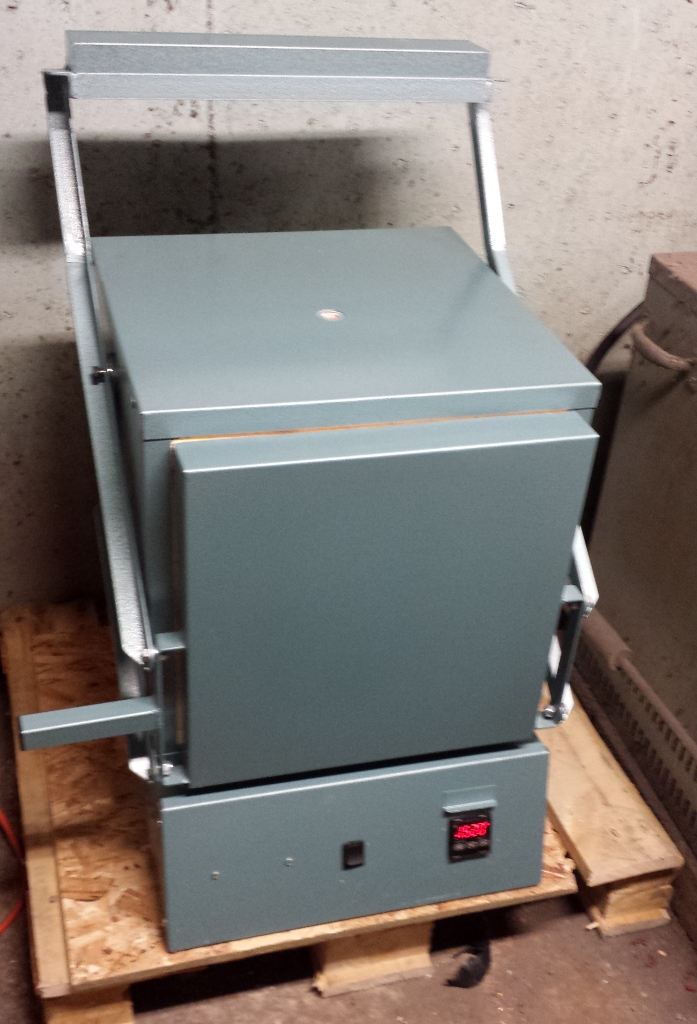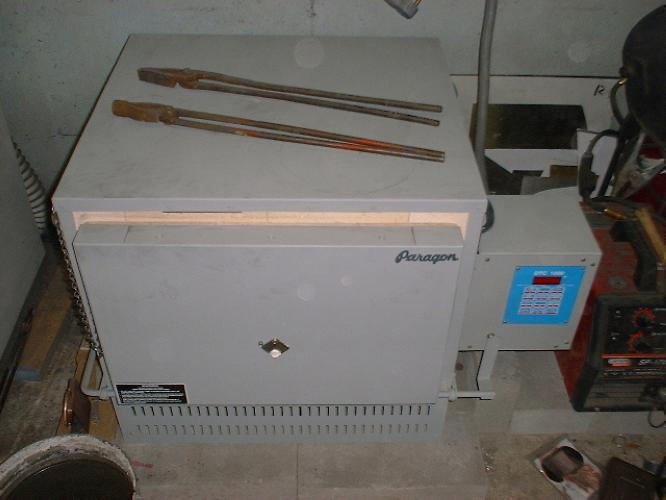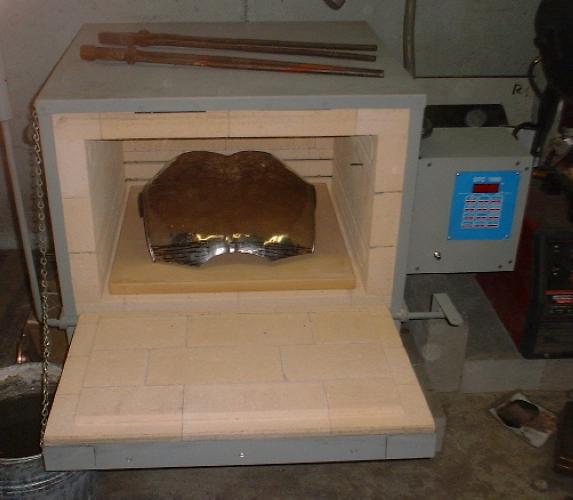


Hardened and Hardenable Metals Suitable for Making Armour
Last Changed: Oct. 22, 2020
General Notes
Notes on the Ductility Needed for Armour
One rule of thumb that I've developed is for how ductile the steel used for full contact armoured combat sport armour should be. In my opinion the absolute minimum lab measured elongation for break for the material at the heat treatment that you are using should be 10%. Based on results seen with 4130 and 17-7ph stainles steel I'd recommend 11.5% for body and 13% for helmets.
Quick Reference for Yield Strength and Ductility:
Mild Steel 29ksi / 39% EBB
304 Stainless Steel 42ksi / 55% EBB
1050 Carbon Steel / C50 / ST50 at Rc39 ~150ksi / ??% EBB
4130 / (EN) 25CrMo4 at Rc48 208ksi / 11.5% EBB
65G / GOST 65 (Russia/Ukraine) ~155ksi / ??% EBB
30HGSA / 30KhGSA (Russia/Ukraine) 192ksi / ??% EBB
410 Stainless Steel at Rc45 156ksi / 12% EBB
17-7ph Stainless Steel (USA) 150ksi / ??% EBB
Full Hard 301 Stainless Steel 140ksi / 9% minimum EBB
17-4ph Stainless Steel (USA) 150ksi / 11% EBB
Titanium - Grade 5 / 6Al-4V (USA) 128ksi / 14% EBB (227ksi adjusted for density)
Titanium - Grade 2 / "Pure titanium" (USA) 49ksi / 28% EBB (85ksi adjusted for density)
Titanium - OT-4 (Russia/Ukraine) 99ksi / 18% EBB (171ksi adjusted for density)
EBB = Elongation Before Break
~ = I'm guessing at the yield strength based on the most similar material that that I can find a material data sheet for.
Types of Armour Metal Commonly Available in the USA
Mild Steel
304 Stainless Steel
1050 Carbon Steel (Hardenable)
4130 (Alloy / Hardenable)
410 Stainless Steel (Hardenable)
17-7ph Stainless Steel (Hardenable)
Full Hard 301 Stainless Steel (Pre-Hardened)
17-4ph Stainless Steel (Hardenable)
Titanium - Grade 5 / 6Al-4V
Titanium - Grade 2 / "Pure titanium"
Types of Armour Metal Commonly Available in Ukraine/Russia
Mild Steel
420 Stainless Steel (Hardenable)
ST50 (0.50% Carbon Steel / Hardenable)
65G (0.65% Carbon Steel / Hardenable)
30HGSA (Alloy Steel / Hardenable)
Types of Armour Metal Commonly Available in India
Mild Steel
304 Stainless Steel
420 Stainless Steel (Hardenable)
Pre-Hardened 202 Stainless Steel
EN9 (0.50% Carbon Steel / Hardenable)
Basic Baseline Metals
Mild Steel / 1008
Relatively speaking it is very easy to shape cold, but has very poor corrosion resistance and a very low yield strength. The 2% yield strength is is 29ksi with an elongation before break of 39%.
304 Stainless Steel / (EN) X2CrNiN18-7
Has a high degree of corrosion resistance and about a 1/3 higher yield strength than mild steel. The dent resistance is generally considered to be that of mild steel 1.33 times its thickness or about two sheet metal gauges.
The 2% yield strength is is 42ksi with an elongation before break
of 55%.
Hardenable Steels
1050 Carbon Steel / C50 / ST50
In the annealed condition it can be shaped much like mild steel. It is heat treated by heating it to 1652F / 900C and quenching in water or oil, then tempering it for 1 hour. When quenched in water and tempered to 752F / 400C resulting hardness is Rc37. It's dent resistance seems to be that of 304 stainless steel around 2.5 times it's thickness.
EN9 / 1055 Carbon Steel
EN9 is a straight carbon steel that is commonly available in India. In the annealed condition it can be shaped much like mild steel. It is heat treated by heating it to 1652F / 900C and quenching in water or oil, then tempering it for 1 hour. When quenched in water and tempered to 842F / 450C resulting hardness is Rc38. It's dent resistance seems to be that of 304 stainless steel around 2.5 times it's thickness.
I do NOT recommend hardening 10XX past Rc40.
4130 / (EN) 25CrMo4
In my opinion 4130 looks to be the best material for SCA, BotN, and ACL armour in all area except rust resistance. The heat treating process is much more forgiving with 4130 than with 1050 carbon steel. The yield strength and ductility are better at higher hardnesses than with 1050.
In the USA 4130 is currently easier to purchase in small amounts than 1050. Welding filler rod is available in 4130, but not in 1050.
The as water quenched hardness for 4130 is Rc52, for 1050 it's Rc62. The effect of this is that accidentally dropping or hitting a 4130 plate that has not been tempered is much less likely to cause it to crack, Tempering temperatures suitable for armour are much lower, than with 1050 carbon steel. The effect of this is that a kitchen oven with a good temperature controller can be used to temper 4130 plates.
To harden 4130 heat it to 1650F to 1700F depending on how long it take you to get it into the quench tank after you open the kiln door and quench it in water. When tempered at 400F for 30 minutes it seems to resist denting as well as 304 stainless steel 2.8 to 3 times its thickness. Data sheets for 4130 stainless steel list the 2% yield strength at that temper as 220ksi with a elongation before break of 10%. When tempered to 500F for 30 minute temper the 2% yield strength at that temper as 208ksi with a elongation before break of 11.5%. When tempered to 600F for 30 minute temper the 2% yield strength at that temper as 195ksi with a elongation before break of 13%.
For ACL armour other than helmets I recommend a 500F / Rc48 temper. For helmets I recommend a 600F / Rc45 temper. If you are using an oven for tempering that only goes up to 550F, that should be fine.
65G / GOST 65 (Russia/Ukraine)
I obtained a fair amount of unhardened 0.8mm Russian 65G (1065) steel. Looking at the 0.65% carbon contain oil rather than water would likely be the better choice for a quenching medium, however not of the other steels that I normally work with use an oil quench. I choose to use a water quench because that is what I had on hand. The critical hardening temperature for this sort of straight carbon steel should be around 800C. To be sure that the thin parts reached full hardness I set the kiln at 900C to account for the parts cooling off between the time that I opened the kiln door and when I submerged the parts in the quench water.
After quenching the parts in water the hardness measured in the Rc57-58 range. A Temper of 30 minutes at 350C resulted in a Rc49, at 400C a Rc43 hardness, and at 450C a Rc37 hardness. While fixing the warp in a large number of brigandine plates I noted that 65G at a Rc43 hardness is far more brittle than 1050 at the same hardness. If the hardened plates required a fair amount of reshaping then cracking around weak points are a significant problem. Even at a Rc37 hardness 65G was much more brittle than 1050 at Rc43 and vastly more brittle than 4130 at a Rc48 hardness.
I recommend using a 1 hour 450C temper for a hardness of Rc37 for 65G steel. I would not recommend hardening 65G pass a Rc37 hardness.
30HGSA / 30KhGSA (Russia/Ukraine)
This alloy is similar to 4130 except that it does not contain any molybdenum. Much of the following information is based on a translation of a research paper on this alloy steel titled "Effect of Tempering on the Facture Toughness of Steel 30KhGSA" by T.M. Golovinskaya and N.I. Chernyak published in Kiev, Ukraine in "Probelmy Prochnosti" on September 16, 1974.
The recommend heat treatment is to heat the steel to 880C and quench it in oil. As a personal note I have found that depending on the how thin the steel is or how quick it is quenched once the furnace is opened it may be required to heat it to 900C or even 920C to reach full hardness. A 340C one hour temper should result in a yield strength of 192ksi / 1324MPa. The steel heat treated with this process I have found to have a hardness of Rc43.
When you compare 30KhGSA to the OT-4 titanium commonly used in armour in Russia and Ukraine 30KhGSA is 94% stronger per volume and 12% stronger by weight. Please note that by stronger I specifically am referring to yield strength, which is a good measure of how well a metal will resist denting. This does not take in to account how much the metal flexes when it is struck by a weapon. When selecting the thickness of alloy steel to use in armour you should keep in mind that even if the armour is undamaged if the wearer is injured it has still failed.
I recommend using a 1 hour 340C temper for a hardness of Rc43 for 30HGSA alloy steel.
Hardenable Stainless Steels
410 Stainless Steel
The corrosion resistance is much less than 304 stainless steel, but much better than mild steel or 1050 spring steel. In the annealed state the yield strength is on par with 304 stainless steel, but the ductility is around half of that of 304 stainless steel.
When heated to 1850F and air quenched and then tempered to 400F for 2 hours it seems to resist denting as well as 304 stainless steel 2.3 times its thickness. Data sheets for 410 stainless steel list the 2% yield strength at that temper as 156ksi with a elongation before break of 12%.
I look at this material as a compromise between 1050 spring steel and 304 stainless steel. You get some of the corrosion resistance of 304 Stainless Steel and some of the dent resistance of 1050 spring steel.
THIS IS VERY IMPORTANT: If you do not temper 410 stainless steel long enough after a water quench it can be very brittle while still having a hardness that looks ok, I do NOT recommend a water quench, it only adds to the stresses that you'll need to relieved during the tempering step. An air quench is safer and easier. I'm not sure if there is any point to oil quenching plates as an air quench seems to work very well and gets the plates to full hardness.
420A Stainless Steel
This is a higher carbon version of 410 stainless steel with 0.15-0.25% carbon. This material seems to be readily available in the Ukraine and Russia, but in the USA it only seems to be available if you are buying a truck load at a time.
Going by the data sheets for this material it seems that a 190-195ksi yield strength with at least a 12% elongation before break. On paper it looks like it MAY be a good choice for armour. Some of the issues are that it still would have the poor rust resistance for something classified as a stainless steel as with 410 stainless steel, it is an "air hardening" steel so hot working or welding are problematic. Another big issue in the USA is that most sheet metal being sold as 420 stainless steel is actually 420B, 420C, or 420HC all of which have too much carbon for use making armour.
17-7ph Stainless Steel (USA)
The corrosion resistance is on par with 301 stainless steel and close to that of 304 stainless steel. In the annealed / condition A state the yield strength is some what lower than 304 stainless steel and the ductility is some what lower than 304 stainless steel. When compared to annealed 410 stainless steel 17-7ph stainless steel is easier to cold form. With the TH1100 heat treatment it resist denting as well as 304 stainless steel 2.2 times its thickness.
According to the material data sheet the yield strength of 17-7ph stainless steel in the RH950 heat treatment condition is 18% higher than the TH1050 condition. However the heat treatment process for the RH950 condition is much more technical, time consuming, and costly. Based on a batch of 17-7ph stainless steel test plates that heat treated to the RH950 condition I saw a noticeable increase in brittleness, but did not notice much of a difference in dent resistance. Please note that I measured the hardness of the test plates to verify that the heat treatment process had been performed correctly. For armour I now recommend a TH1100 heat treatment. I saw enough failures of 17-7ph stainless steel armour heat treated to TH1050 to warrent this change.
Please note that an electric kiln with an automatic temperature controller is needed to heat treat 17-7ph stainless steel. Also, due to the length of the heat treating process 17-7ph stainless steel is much more costly to have commercially heat treated than 1050, 4130, or 410 stainless steel. The cost of the 17-7ph stainless steel sheet metal is also much higher than 1050, 4130, or 410 stainless steel.
High Yield Strength or Pre-Hardened Metals
Full Hard 301 Stainless Steel
The corrosion resistance is close to that of 304 stainless steel. This material is difficult to shape so it is only useful for parts that have only a simple curve or a moderate compound curve. The dent resistance seems to be that of 304 stainless steel of 1.8 to 2 times its thickness.
202 Stainless Steel Hardened to HRC40
201/202 Stainless Steel is a somewhat lower cost version of 301/302 Stainless Steel. Hardened 202 is common available in India where as hardened 301/302 Stainless Steel is not generally available there. The corrosion resistance is close to that of 304 stainless steel. This material is difficult to shape so it is only useful for parts that have only a simple curve or a moderate compound curve. The dent resistance seems to be that of 304 stainless steel of 1.8 to 2 times its thickness.
This material is hardened at the steel mill by passing it through a rolled mill cold until it work hardens to Rc40. I do not recommend using 202 Stainless Steel that has been hardened more than HRC42. If this material is hot work then it returns to its annealed state and can not be rehardened.
17-4ph Stainless Steel
The corrosion resistance is close to that of 304 stainless steel. This material is very difficult to shape so it is only useful for parts that have only a simple curve or a slight compound curve. This material should be heat treated before it is shaped. Heat Treating it to H1150 only slightly increases the yield strength, but it increases the ductility from a 5% elongation before break to 11%.
301 full hard stainless steel is about half the price when I checked. The yield strength of 17-4ph stainless steel at a heat treatment ductile enough for armour is very close to that of 301 full hard stainless steel. 17-4ph stainless steel requires heat treating, but 301 full hard stainless steel does not. I don't see any good reason to choose 17-4ph stainless steel over 301 full hard stainless steel.
Titanium - Grade 5 / 6Al-4V (USA)
This material does not rust. The yield strength per volume is 128ksi / 880MPa and the density is 4.43 g/cc / 0.160 lb/in³. The density of 4130 alloy steel is 7.85 g/cc / 0.284 lb/in³ so it is 1.775 times heavier per volume. If you multiple the 1.775 by the 128ksi yield strength to get a idea of the strength to weight relative to 4130 alloy steel it is 227ksi / 1565MPa, which is 9% more than the 208ksi / 1434MPa. The elongation before break is 14%.
Titanium - Grade 2 / "Pure titanium" (USA)
The material does no rust. The yield strength per volume is 49ksi / 340MPa and the density is 4.51 g/cc / 0.163 lb/in³. The density of 4130 alloy steel is 7.85 g/cc / 0.284 lb/in³ so it is 1.742 times heavier per volume. If you multiple the 1.742 by the 49ksi yield strength to get a idea of the strength to weight relative to 4130 alloy steel it is 85ksi / 586MPa, which is 41% less than the 208ksi / 1434MPa. The elongation before break is 28%.
Titanium - OT-4 (Russia/Ukraine)
The material does not rust. The yield strength per volume is 99ksi / 685MPa and the density is 4.51 g/cc / 0.164 lb/in³. The density of 4130 alloy steel is 7.85 g/cc / 0.284 lb/in³ so it is 1.732 times heavier per volume. If you multiple the 1.732 by the 99ksi yield strength to get a idea of the strength to weight relative to 4130 alloy steel it is 171ksi / 1179MPa, which is 18% less than the 208ksi / 1434MPa.
Copyright 2014 Craig W. Nadler All rights reserved